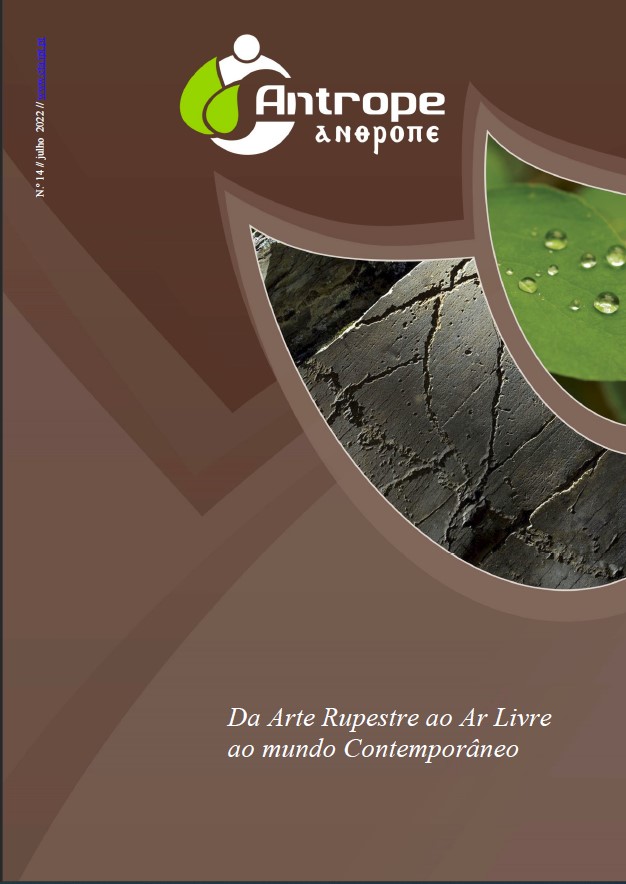
ANTROPE
Antrope is made up of:
- Antrope Magazine: Annual Periodical Publication
- Antrope Monographic Series
- Antrope Reports
Antrope Journal aims to promote scientific research, publication and communication, fostering a culture of personal and professional development. Antrope Revista aims to be a space for communication, dissemination and scientific reflection for all professionals, researchers and students of any academic degree in the fields of Archaeology, Archaeological Heritage, Anthropology and Archaeosciences.
Antrope Revista also aims to place special emphasis on promoting a culture of scientific publication among students, archaeologists and scientists at any stage of their career, as well as encouraging those at the start of their careers. Revista Antrope is open to submissions from all those who share a common interest in developing and applying scientific methods to inform key debates by improving the quality and reliability of scientific information derived from archaeological research.
Antrope Monographic Series will be open to anyone interested in publishing a monograph, conference proceedings or dissertation.
Antrope Reports presents itself as a publication opportunity for companies working in the field of emergency archaeology and for colleagues who usually carry out activities in this field but find it difficult to publish their work reports. In Antrope, you will find a publication dedicated to giving visibility to this type of work, which is often poorly publicised.
Editor: Sara Garcês | Instituto Politécnico de Tomar | saragarces@ipt.pt
Scientific committee:
Alexandra Figueiredo - Uso de Tecnologias e Arqueologia Subaquática, Instituto Politécnico de Tomar
Ana Bettencourt - Arqueologia, Universidade do Minho
Erika Robrahn-Gonzalez - História, Arqueologia, Grupo DOCUMENTO/Brasil - Especialista em Estratégias do Património Cultural/Políticas Sociais
Helena Gonçalves Pinto - Arquitetura/História, UAL - Turismo e Património
Hugo Gomes - Geologia, Geomorfologia, Arqueometria de Pigmentos, Geoparques - Instituto Terra e Memória, Centro de Geociências
José Júlio Garcia Arranz - História de Arte, Universidade da Extremadura, Espanha
Judite Nascimento - Geografia, Ordenamento do Território e Urbanismo - Universidade de Cabo Verde
Juliano Bitencourt - Arqueologia, Laboratório de Arqueologia Pedro Ignácio Schmitz (LAPIS), Universidade do Extremo Sul Catarinense (UNESC) Criciúma/SC, Brasil
Leonor Medeiros - Arqueologia Industrial, (CHAM - NOVA FCSH)
Luiz Oosterbeek - Arqueologia Pré-Histórica, Gestão do Património, Instituto Politécnico de Tomar
Rodrigo Banha - Arqueologia Urbana, CHAM-FCSH
Telmo Pereira - Arqueologia Pré-Histórica, Universidade Autónoma de Lisboa
Thomas Wyrwoll - Arqueologia, Petroiconologia, Zoologia – German Association for Rock-Art Research & Icono-Archaeological Mammalian Zoology
Vasco Mantas - Arqueologia Romana, Universidade de Coimbra
Important information:
We accept manuscripts written in the following languages: English, Spanish, French and Portuguese.
Articles submitted to Antrope Journal and to the Monografic Series will be subject to approval and peer review on an anonymous basis.
Submission dates for Antrope Journal: By the 15th of April for the July issue and by the 30th of October for the December issue.
Download the guidelines for authors for Antrope Journal here.
Download the guidelines for authors for Antrope Monography here.
Download the guidelines for authors for Antrope Reports here.
Antrope fulfils the quality requirements established for scientific journals. The refereeing system is based on peer review, in which all articles are reviewed by members of the Scientific Committee and also by suitable external reviewers, who are invited depending on the subject of the article.
It is officially registered under ISSN 2183-1386
It is officially registered with the INPI and registered with the ERC.
Online directory: Regional Information Service for Scientific Journals in Latin America, the Caribbean, Spain and Portugal.
Journal
14 . julho . 2022
Artigos
9-28SANTUÃRIOS DE ARTE RUPESTRE AO AR LIVRE NO ALENTEJO: O CASO DO PENEDO DO FERRO (MONFORTE, PORTUGAL)
Leonor Rocha, Paula Morgado
29-56¿CÃMO MEJORAR NUESTRAS ACTIVIDADES DIVULGATIVAS?: DISEÃO DE FORMULARIOS PARA CONOCER LA OPINIÃN DEL USUARIO
Nidia Aliseda, Juan F. Gibaja, Millán Mozota, menairo@hotmail.com
57-121LA INVESTIGACION ACTUALISTICA Y EXPERIMENTAL EN LOS ESTUDIOS LITICOS DE SUDAMERICA
Hugo G. Nami
122-141ANÃLISE ANTROPOLÃGICA DO MATERIAL OSTEOLÃGICO PROVENIENTE DO MONUMENTO MEGALÃTICO ANTA II DO REGO DA MURTA, ALVAIÃZERE (LEIRIA): CASO DE ESTUDO DE UM INDIVÃDUO ADULTO COM PATOLOGIA TRAUMÃTICA E SUA RELAÃÃO COM O CONTEXTO DEPOSITADO
Daniel Alves, Augusto Ferreira, alexfiga@ipt.pt
142-168CONTRIBUTOS PARA O ESTUDO DA PALEOFARINAÃÃO NO VALE DO SOUSA SUPERIOR: O CASO DO TERRITÃRIO DE LOUSADA ENTRE O IV MILÃNIO E O SÃCULO VI D.C.
Manuel Nunes, Paulo Lemos
169-176POSSÃVEL ITINERÃRIO ROMANO POR TAROUCA
José dâEncarnação, José Carlos Santos
177-190ESTATUETA DE BRONZE DE VALE DO JUNCO (ORTIGA, MAÃÃO)
José dâEncarnação, Fernando Coimbra
191-214INTERVENÃÃO ARQUEOLÃGICA NA RUA 25 DE ABRIL, N.º 56, SANTA CRUZ, GRACIOSA
José LuÃs Neto, LuÃs Borges, Tânia Manuel Casimiro
215-266INTERVENÃÃO ARQUEOLÃGICA NO CASTELO DA ROCHA NEGRA, CEDROS, FAIAL
José LuÃs Neto,LuÃs Borges, Tânia Manuel Casimiro
267-289QUINTAIS URBANOS: A MATERIALIDADE EVIDENCIADA PELA ARQUEOLOGIA NO CENTRO HISTÃRICO DE BELÃM-AMAZÃNIA-BRASIL
Ana Paula Claudino Gonçalves
